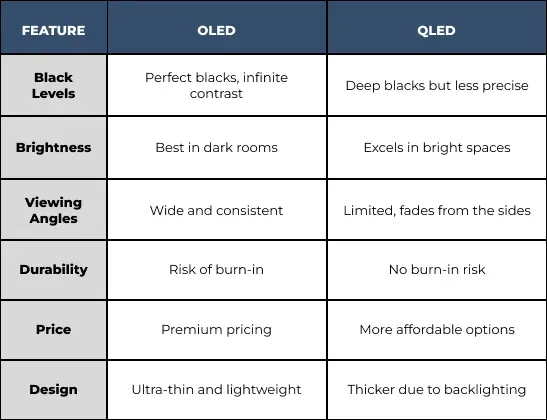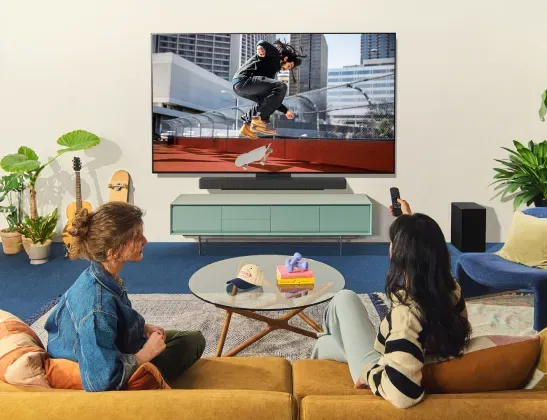OLED vs. QLED: Pros and Cons
Wed Nov 27 2024
- Electronics
Picking the right television doesn’t have to be a headache. OLED and QLED each deliver stunning visuals, but they shine in different ways. Let’s cut through the tech jargon and focus on what really matters so you can find the right LED TV for your space and preferences!

What is OLED?
OLED TVs, or Organic Light-Emitting Diode, are a display technology in which each pixel produces its own light. This creates stunning visuals with vibrant colors and deep contrast.
Why Choose OLED?
-
Perfect Blacks: OLEDs turn off individual pixels for true black, creating unmatched contrast.
-
Wide Viewing Angles: Colors and brightness stay consistent, even from the sides.
-
Ultra-Thin Design: OLED TVs are lightweight and sleek, perfect for modern setups.
-
Superior Contrast: Each pixel’s self-lighting gives incredible depth to images.
OLED Drawbacks
-
Higher Cost: OLED TVs tend to be more expensive.
-
Lower Brightness: They aren’t as bright as QLEDs, which can be a drawback in well-lit rooms.
-
Burn-In Risk: Static images left on the screen for too long can cause burn-in, though it’s less common with newer models.
💡 Curious about OLED TV maintenance? Read our related blog: How To Clean My OLED TV
What is QLED?
QLED TVs, or Quantum Dot Light Emitting Diode, use LED technology enhanced with quantum dots. This design focuses on brightness and color accuracy, making it a great choice for bright spaces.
Why Choose QLED?
-
Exceptional Brightness: QLED TVs excel in bright rooms.
-
Vivid Colors: Quantum dots produce a wider range of colors with precision.
-
Budget-Friendly Options: QLED TVs come in a variety of price points.
-
No Burn-In Risk: Unlike OLEDs, QLED screens handle static images without any risk of burn-in.
QLED Drawbacks
-
Limited Viewing Angles: Colors and brightness can fade when viewed from the side.
-
Lower Contrast: QLEDs can’t achieve the perfect black levels of OLEDs.
-
Thicker Design: The backlighting makes QLED TVs bulkier.
OLED vs. QLED: A Quick Comparison

Best OLED TVs to Consider
LG OLED evo M Series 83-Inch 4K Smart TV (Model: OLED83M3PUA)
-
Revolutionary Wireless Tech: The world’s first consumer TV with 4K 120Hz wireless connectivity, eliminating cable clutter and allowing flexible placement.
-
Unmatched Picture Quality: Powered by the α9 AI Processor Gen6, delivering brighter visuals and optimized sound for an unforgettable viewing experience.
-
Game-Changing Gaming: With a 0.1 ms response time, NVIDIA G-Sync, and three HDMI 2.1 ports, this TV is a gamer’s dream.
-
Sleek, Modern Design: Includes a near-flush wall mount and the innovative Zero Connect Box for a clean setup.
LG OLED evo C3 65-Inch Class 4K Smart TV (Model: OLED65C3PUA)
-
AI-Powered Picture and Sound: Powered by the \u03b19 AI Processor Gen6, the OLED evo C3 optimizes picture quality, enhances brightness, and adjusts sound settings to match your content seamlessly.
-
True-to-Life Colors: With 100% Color Volume and Color Fidelity, enjoy vibrant and accurate colors in every frame, from the darkest blacks to the brightest highlights.
-
Home Theater Magic: Experience Dolby Vision for cinematic visuals and Dolby Atmos for immersive sound. FILMMAKER MODE(TM) ensures movies appear just as directors intended.
-
Smart TV Features: ThinQ AI and webOS make streaming simple, with Quick Cards to organize your favorite apps and instant access to 300+ free LG channels.

Best QLED TVs to Consider
Samsung 98" Class Neo QLED 4K QN90A (Model: QN98QN90AAFXZA)
-
Stunning Picture Quality: Exclusive Mini LED technology delivers hyper-focused brightness and dimming, making every scene pop with incredible detail.
-
AI-Enhanced 4K: The Neo Quantum Processor 4K uses AI to upscale content to jaw-dropping 4K clarity, no matter the source.
-
Vibrant Colors and Contrast: HDR10+ dynamic tone mapping ensures rich colors and deep contrast, bringing every frame to life.
-
Ultimate Gaming Features: With Motion Xcelerator 4K 120Hz and Super Ultrawide Game View, this TV is built for seamless, lag-free gaming.
Samsung 85" Class Neo QLED 4K QN95D (Model: QN85QN95DAFXZA)
-
Crisp and Bright Picture: Mini LED precision lighting highlights every detail, whether it’s a blockbuster or live sports.
-
AI-Driven Performance: The AI-powered processor sharpens visuals and adapts settings for the best possible picture and sound.
-
No Distractions: Anti-reflection technology keeps your viewing experience glare-free, day or night.
-
Depth and Realism: Real Depth Enhancer Pro adjusts every frame to add dimension and bring images to life.
Which TV is Right for You?
Here’s how to choose:
-
Dark Room Viewing: Go for OLED if you love cinematic quality and perfect blacks.
-
Bright Room or Gaming: Choose QLED for its high brightness and durability.
-
Budget-Friendly Options: QLED often has more affordable choices without compromising quality.

Find Your Perfect TV at Silica
Silica For Your Home offers a wide range of OLED and QLED TVs, and we’ll help you find the TV that matches your style and needs. Contact us today or visit our Silica store locations in Fond du Lac, Beaver Dam, and Watertown, Wisconsin, to explore our selection of electronics, including home theater electronics, audio electronics, home projectors, and more.
👉Visit our store or browse online today to bring the ultimate viewing experience to your home today!
Related readings from our blog:
FAQ: OLED vs. QLED TVs
1. Is QLED or OLED better?
It depends on your needs. OLED is best for deep blacks, wide viewing angles, and cinematic picture quality. QLED excels in brightness, vibrant colors, and durability, making it ideal for bright rooms and gaming.
2. Is QLED worth the extra money?
If you prioritize brightness, vibrant colors, and longevity in a well-lit room, QLED is worth the investment. It offers a great balance of performance and durability.
3. Which lasts longer, QLED or OLED?
QLED TVs generally last longer because they don’t face issues like burn-in. With proper care, both types can last many years, but QLED has an edge in durability.
4. Which TV is good for eyes, OLED or QLED?
OLED TVs are generally considered better for the eyes because they emit less blue light and offer more natural contrast. QLEDs are brighter, which might cause more strain in dark rooms.
5. Is burn-in still a problem with OLED?
Burn-in is rare in modern OLED TVs and typically only happens with a prolonged display of static images. Regular viewing habits significantly reduce the risk.
Related Articles
Welcome to our website! As we have the ability to list over one million items on our website (our selection changes all of the time), it is not feasible for a company our size to record and playback the descriptions on every item on our website. However, if you have a disability we are here to help you. Please call our disability services phone line at 920-929-0126 during regular business hours and one of our kind and friendly personal shoppers will help you navigate through our website, help conduct advanced searches, help you choose the item you are looking for with the specifications you are seeking, read you the specifications of any item and consult with you about the products themselves. There is no charge for the help of this personal shopper for anyone with a disability. Finally, your personal shopper will explain our Privacy Policy and Terms of Service, and help you place an order if you so desire. Any information provided during the ordering process may be used to contact you regarding your order, updates, promotions, or other communications related to our services. We respect your privacy and will not share your information with third parties without your consent.
Copyright © 2009 - 2025 Company All Rights Reserved.
This site is protected by reCAPTCHA and the Google Privacy Policy and Terms of Service apply.

.webp)